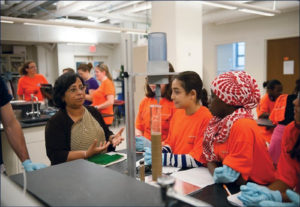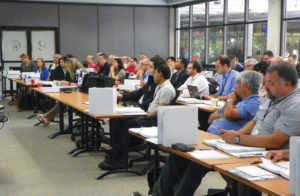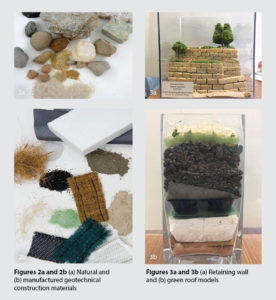Introduction
This article is part of a 4-part series on how engineering students or practicing engineers learn about geosynthetic materials. Geosynthetic materials have been used in civil and environmental engineering applications for more than three decades. The benefits of geosynthetic materials are widely recognized, and they are used in a variety of industries. The high demand for geosynthetic materials, ranging from transport to containment industries, is growing, and new products are continuously being introduced to the market. Therefore, it is imperative that our civil and environmental engineering students, both undergraduate and graduate, learn about geosynthetic materials and their use in design.

Coursework
At Syracuse University, in the Department of Civil and Environmental Engineering, geosynthetic materials are being introduced in both undergraduate and graduate courses at many different levels. Polymers, products, properties, design, and innovations are discussed within a framework of exploration, applications, and innovative solutions to complex designs and societal issues. For K–12 education, simple hands-on experiments have been developed for water filtration and dewatering of soil sediments. In both experiments, students use sands and geotextiles as filters and learn their differences (Figure 1). In our introductory course (ECS 101), students are shown a wide range of geosynthetic materials and soils, and a local project is discussed on the instability of an excavation due to seepage. Students see the role of geotextiles and gravel for soil piping and seepage mitigation. At the junior level, in required course CIE 337 (An Introduction to Geotechnical Engineering), along with rocks and soils, geosynthetic materials are introduced as manufactured construction materials (Figures 2a and 2b). Students measure physical, hydraulic, and shear strength properties of geosynthetic materials. In our senior capstone design course (CIE 475), we have seen an increase in the number of students exploring the use of geosynthetic geotextiles, geogrids, geomembranes, and rolled erosion control products for their design projects. These students are provided a Geosynthetics Specifier’s Guide (published by IFAI), design examples, and case studies. At Syracuse University, a technical elective (CIE 584: Designing with Geosynthetics) has been taught for the last sixteen years. This is a design elective for undergraduate students and a required course for all graduate students pursuing an MS or PhD in geotechnical engineering. Students work on five to six different design projects, such as retaining walls and embankments on soft soils, geotextile tube dewatering, liners for solar ponds, landfill stability, and use of rolled erosion control products for soil erosion mitigation. Efforts are made to select local design projects through geotechnical consultants and alumni. Every year, two to three geosynthetic manufacturers are invited to campus to discuss case histories, software, and innovative geosynthetic products. Students are also encouraged to make models to demonstrate the use of geosynthetic materials in design (Figures 3a and 3b).
Although geosynthetic materials are introduced formally in CIE 337 and CIE 584 and informally in ECE 101 and CIE 475 at Syracuse University, it is not enough. A small number of undergraduate students take the more rigorous technical elective, Designing with Geosynthetics. Therefore, the majority of undergraduate students leave campus with a limited knowledge of geosynthetic materials. It is critical that geosynthetic materials be introduced in several required undergraduate courses, such as Engineering Materials and Foundation Design, in addition to introductory geotechnical engineering courses. Educational materials that can be readily introduced in these required courses should be developed by the geosynthetic community and widely distributed to civil and environmental engineering departments in the U.S. and Canada. Speakers from the geosynthetics industry, with interesting case studies, should offer to present seminars to student chapters, such as the American Society of Civil Engineers (ASCE) and the North American Chapter of the International Geosynthetics Society (IGS–NA). These efforts may result in a wider, broad-based knowledge of geosynthetic materials and their role in design.
The North American Chapter of the International Geosynthetics Society (IGS–NA) believes education is essential to attain the appropriate and widespread use of geosynthetics as engineering materials. As the learned society for geosynthetics in North America, our members are engineers, educators, manufacturers, regulators and researchers collectively dedicated to creating opportunities for sharing new knowledge and developing a better understanding of geosynthetics.
Our educational goals are to:
- Train future users of geosynthetics
- Train geosynthetic educators
- Promote geosynthetics as part of engineering curricula
- We have designed two exciting programs to work toward these goals:
- Educate the Educators: A Geosynthetics Training Program for University Professors
- Educate the Students: A Guest Lecture Series for University Students
Educate the Educators
Modern civil engineering graduates need fundamental education on geosynthetic materials. Many schools do not teach geosynthetics because their instructors may not have the knowledge, confidence, or materials to effectively teach geosynthetics. Educate the Educators (EtE) is designed to provide specialized, hands-on training and lecture materials to equip professors to offer effective geosynthetics content at their schools. Our fundamental goal is to enable interested professors with the knowledge and materials to deliver at least one class on geosynthetic functions, types, and applications. For ease of implementation in engineering programs that already are packed with content, we suggest the class be incorporated into students’ first civil engineering materials or geotechnical engineering courses. We provide much deeper training to increase confidence in providing geosynthetics content early on, and encourage and provide more lecture material that can be used in senior level and graduate courses.
Educate the Educators uses geosynthetic experts to train professors. We provide high-quality, modern slides and notes that communicate the state-of-knowledge and -practice. Photographs from industry make the slides more engaging and relevant for students. We assemble and provide generically labeled geosynthetic samples for hands-on learning and have developed a geosynthetics identification workshop for professors to use with their students. We provide suggestions and facilitate discussions with professors on how to include geosynthetics in their courses.
Our most recent Educate the Educators event was held July 28–29, 2015, in Austin, Texas. Forty-five professors participated, of which 45% had 6 or fewer years of experience, 25% had 7–10 years of experience, and 30% had 11 or more years of experience. This led to high-quality exchanges between the participants on education content and delivery methods. More than half the group were somewhat familiar with geosynthetics—exactly the key target group to expand geosynthetics education. Those very familiar with geosynthetics contributed their expertise and ideas in small group discussions, and received the latest state-of-practice content on wall and slope reinforcement, road and pavement applications, and environmental protection.
The training sessions were led by IGS–NA members Dr. Jorge Zornberg of the University of Texas at Austin, geotechnical consultant Dr. Barry Christopher, and myself. Corporate sponsors contributed to the program by providing informative and interesting case histories, as well as hands-on laboratory explanations and demonstrations by technical experts. This noncommercial educational event was chaired by Boyd Ramsey of GSE Environmental and created by the International Geosynthetics Society (IGS). The event was hosted by IGS–NA and supported by generous sponsors, including the Geosynthetic Materials Association, the Geosynthetic Institute, TenCate Geosynthetics, the Erosion Control Technology Council, Presto Geosystems, GSE Environmental, HUESKER, Thrace-LINQ, and TRI.
Building on the success of EtE Austin, our next event will be held Dec. 4–5, 2017, in Kingston, Ontario, Canada. We are very excited to have three exceptional educators and pioneering researchers as the EtE lead instructors:
- Dr. R. Kerry Rowe of Queen’s University
- Dr. Richard J. Bathurst of the Royal Military College of Canada
- Dr. Jorge Zornberg of the University of Texas at Austin
To be effective, we believe it is essential for this training to occur face-to-face and in a small group. Industry has provided generous financial support to allow us to pay for the accommodation and hosting expenses for our participants. Please visit www.igs-na.org to see an up-to-date list of industry sponsors. We are very pleased with the interest and caliber of the class of professors who will be participating—they are looking to either implement or improve geosynthetics education at their schools. We look forward to reporting on the outcomes of EtE Kingston and have plans to offer the program again.

Educate the Students
Educate the Educators is our long-term strategy to train future users of geosynthetics. We also want to directly Educate the Students (EtS) by offering engaging and effective geosynthetic lectures that will immediately impact engineers-in-training. If EtE can be thought as teaching our schools how to fish, then Educate the Students is quite simply, just giving them the fish. The lectures will be tailored to the needs of each school, be it fundamental or specialized geosynthetics content. Particular focus will be made on large engineering schools not offering geosynthetics content. Industry support is needed to help pay for the travel expenses of our selected speakers to deliver these lectures. Please contact me if you would like to help organize an EtS event.
All members in our industry can help by reaching out to your alma mater. Contact your past professors, or even better, department chairs. Tell them why geosynthetics education is essential for modern civil engineering graduates. Tell them IGS–NA is here to help, and that they can reach us at www.igs-na.org or me at brachman@queensu.ca.
Richard Brachman, PhD, is the president of IGS–NA and a professor of geotechnical and geoenvironmental engineering at Queen’s University.
Shobha K. Bhatia, PhD, is the Laura J. and L. Douglas Meredith Professor in civil and environmental engineering at Syracuse University.
 TEXTILES.ORG
TEXTILES.ORG




With all due respect, it appears that some of those involved in the valuable EtE program may be unaware of the true history of geosynthetics. The above article proclaims that “Geosynthetic materials have been used in civil and environmental engineering applications for more than three decades”. In actuality, the year 2018 celebrates ‘six’ decades since the first use of geosynthetics in a civil engineering application in the United States, and the beginning of their arduous journey into history. In 1972, four and one-half decades ago and after ten years of project tests, the USACOE issued their first comprehensive specification for this material containing test methods still used today. A detailed account of this history can be found here: http://carthagemills.com/Geosynthetics-how-it-all-began.php
Thank you